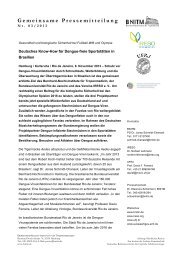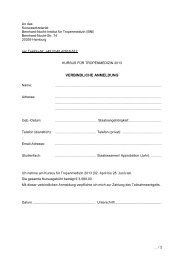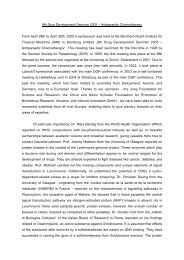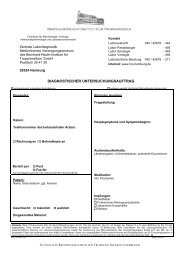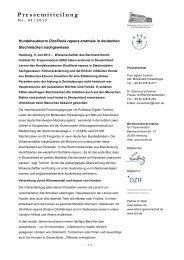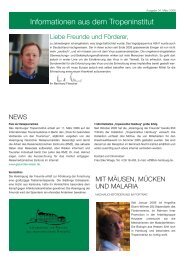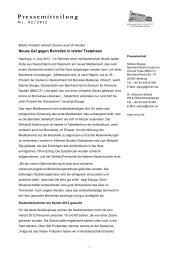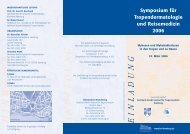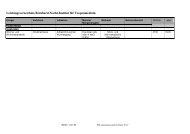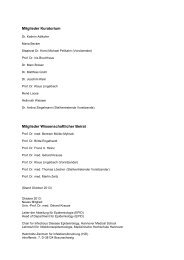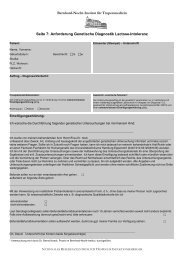Research Group Heussler (Malaria I) - Bernhard-Nocht-Institut für ...
Research Group Heussler (Malaria I) - Bernhard-Nocht-Institut für ...
Research Group Heussler (Malaria I) - Bernhard-Nocht-Institut für ...
Create successful ePaper yourself
Turn your PDF publications into a flip-book with our unique Google optimized e-Paper software.
Parasitology Section<br />
Nematode-specific regulation of S-adenosylmethionine<br />
decarboxylase offers a novel strategy for enzyme inhibition<br />
Zusammenfassung<br />
Onchocercose (Flussblindheit) stellt weiterhin ein<br />
bedeutendes Gesundheitsproblem in zahlreichen<br />
afrikanischen Staaten dar. Da mit Ivermectin zur Zeit<br />
nur ein Medikament <strong>für</strong> die Massentherapie zur Verfügung<br />
steht, ist die Identifizierung neuer Ziele <strong>für</strong><br />
die Chemotherapie im Stoffwechsel des Erregers<br />
Onchocerca volvulus dringend erforderlich. Polyamine<br />
sind <strong>für</strong> Wachstums- und Differenzierungsprozesse<br />
essenziell, weshalb ihr Stoffwechsel als ein<br />
vielversprechender Angriffspunkt <strong>für</strong> die Chemotherapie<br />
gilt. Im Polyamin-Syntheseweg ist die S-Adenosylmethionin-Decarboxylase<br />
(AdoMetDC) ein Schlüsselenzym,<br />
das decarboxyliertes S-Adenosylmethionin<br />
<strong>für</strong> die Synthese von Spermidin und Spermin bereitstellt.<br />
Für das humane Enzym ist bekannt, dass<br />
seine enzymatische Aktivität durch das Vorläufermolekül<br />
Putrescin stimuliert wird. Vergleichende Studien<br />
zeigen nun, dass sich die AdoMetDC der parasitischen<br />
Filarie O. volvulus und des freilebenden<br />
Modellnematoden Caenorhabditis elegans hinsichtlich<br />
dieses Regulationsmechanismus vom humanen<br />
Enzym unterscheiden. Die ermittelten spezifischen<br />
Eigenschaften der Nematoden-AdoMetDC sind eine<br />
geringe Aktivität des nichtstimulierten Enzyms und<br />
eine geringere Spezifität gegenüber dem Stimulatormolekül.<br />
Diese Besonderheiten sollen ausgenutzt<br />
werden, um mit einer neuen Strategie die Nematodenenzyme<br />
spezifisch über die Stimulator-Bindungstasche<br />
zu inhibieren. Dazu wurden erste Inhibitionstests<br />
mit Polyaminanaloga durchgeführt.<br />
Introduction<br />
The human filarial parasite Onchocerca volvulus causes<br />
onchocerciasis. The disease is endemic in 37 African<br />
countries affecting about 15 million people. To date the<br />
only existing drug against this parasitic nematode is<br />
ivermectin. However, ivermectin kills only the microfilariae<br />
of O. volvulus and has hardly any efficacy on adult<br />
worms that survive in their human host for up to 14<br />
years, with females producing constantly microfilariae.<br />
Due to the lack of a laboratory host for O. volvulus, the<br />
worm is inaccessible for physiological studies. However,<br />
in recent years the model nematode Caenorhabditis<br />
elegans has become a useful system to study certain<br />
aspects of the metabolism of parasitic nematodes.<br />
The naturally occuring polyamines putrescine, spermidine<br />
and spermine are aliphatic polycations found in all<br />
organisms. Since polyamines are essential for growth<br />
and developmental processes, targeting their metabolism<br />
is a promising approach in anti-parasite research.<br />
The polyamine synthetic pathway contains two regulatory<br />
steps catalysed by ornithine decarboxylase and<br />
36<br />
S-adenosylmethionine decarboxylase (AdoMetDC). The<br />
latter provides decarboxylated S-adenosylmethionine<br />
that is used to form the polyamines spermidine and<br />
spermine, respectively. The AdoMetDC from the nematodes<br />
O. volvulus and C. elegans have been previously<br />
cloned and characterised in our department (Da’dara<br />
et al. 1996, Biochem J 320: 519-30; Da’dara and Walter,<br />
1998, Biochem J 336: 545-50). In the present study<br />
we have detected a nematode-specific regulation of<br />
AdoMetDC. Based on these findings a novel strategy<br />
to inhibit nematode AdoMetDC is proposed.<br />
Figure 1: Different effects of natural polyamines on nematode<br />
and human AdoMetDC activity Dose-dependent stimulation of<br />
A) O. volvulus, B) C. elegans and C) human AdoMetDC by<br />
putrescine (�), spermidine (�) and spermine (�). The basis<br />
activity of the human enzyme is indicated by the dotted blue<br />
line. Nematode AdoMetDCs highly depend on an activator<br />
and their enzyme activity is stimulated not only by putrescine<br />
but also by spermidine and spermine.



